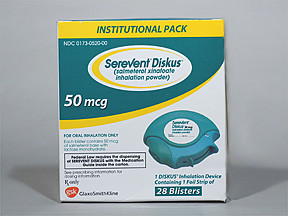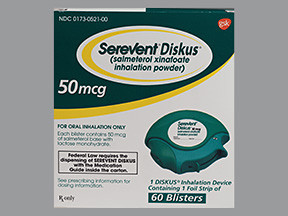SALMETEROL DISK INHALER - ORAL
PHONETIC PRONUNCIATION: (sal-MET-er-all)
COMMON BRAND NAME(S): Serevent Diskus
GENERIC NAME(S): salmeterol xinafoate
Uses
USES: Salmeterol is used as a long-term (maintenance) treatment to prevent or decrease wheezing and trouble breathing caused by asthma or ongoing lung disease (chronic obstructive pulmonary disease-COPD, which includes chronic bronchitis and emphysema). It should only be used long-term if your asthma symptoms are not controlled by your other asthma medications (such as inhaled corticosteroids). Salmeterol must not be used alone to treat asthma. (See also Warning section.) It is also used to prevent asthma brought on by exercise (bronchospasm). Salmeterol works in the airways by relaxing muscles and opening air passages to improve breathing. Controlling symptoms of breathing problems can decrease time lost from work or school. This medication does not work right away and should not be used for sudden attacks of breathing trouble. Your doctor must prescribe a quick-relief medicine/inhaler (e.g., albuterol) for sudden shortness of breath/asthma attacks while you are on this medication. You should always have a quick-relief inhaler with you. Consult your doctor or pharmacist for more details. This medication should be used in combination with other medications such as long-acting inhaled corticosteroids. However, it should not be used with other long-acting inhaled beta agonists (e.g., formoterol, combination salmeterol/fluticasone) since this may increase your risk for side effects. It is recommended that children and teenagers, who need to use salmeterol to treat their asthma, should use a combination salmeterol/fluticasone product. Check with your child's doctor to see if this product is the right product for your child. In patients with asthma, this medication should not be used when breathing problems can be controlled with inhaled corticosteroids (e.g., flunisolide, fluticasone) and occasional use of quick-relief inhalers. (See also Warning section.) If you are regularly taking corticosteroids by mouth (e.g., prednisone), you should not stop using them or use this inhaled medication instead. Continue to follow your doctor's instructions for taking the corticosteroids by mouth.
How to use SALMETEROL DISK INHALER - ORAL
HOW TO USE: Read the Medication Guide available from your pharmacist before you start using salmeterol and each time you get a refill. Refer to the illustrated directions provided by the manufacturer for directions on how to use this device. If any of the information is unclear, consult your doctor or pharmacist. Always activate and use this device in a level, horizontal position. Inhale this medication by mouth, usually twice daily in the morning and evening (12 hours apart), or use as directed by your doctor. You may or may not taste/feel the drug when you inhale. Either is normal. Never exhale into the device. Do not use with a spacer. Never wash the mouthpiece or any part of the device. If you are using other inhalers at the same time, wait at least 1 minute between the use of each medication. The dosage is based on your medical condition and response to therapy. Use this medication regularly to receive the most benefit from it. To help you remember, use it at the same times each day. Do not use it more often than prescribed or use more than 1 inhalation twice daily since this may increase the risk of side effects. Do not stop taking this medication or change your dose without consulting your doctor. Some conditions may become worse when the drug is suddenly stopped. Your dose may need to be gradually decreased. If you have been using a quick-relief inhaler on a regular daily schedule (such as 4 times daily), you must stop this schedule and only use it as needed for sudden shortness of breath/asthma attacks. Consult your doctor for details. If you are only using this medication occasionally to prevent asthma brought on by exercise (bronchospasm), use it at least 30 minutes before exercise, and do not use another dose for at least 12 hours. If you have sudden asthma/shortness of breath, use a quick-relief inhaler (e.g., albuterol). Consult your doctor for details. If this medication stops working well, or you need to use your quick-relief inhaler more often than usual (4 or more puffs daily or use of more than 1 inhaler every 8 weeks), seek immediate medical attention. It may be a sign of worsening asthma, which is a serious condition. Learn which of your inhalers you should use every day (controller drugs) and which you should use if your breathing suddenly worsens (quick-relief drugs). Ask your doctor ahead of time what you should do if you have new or worsening cough or shortness of breath, wheezing, increased sputum, worsening peak flow meter readings, waking up at night with trouble breathing, if you use your quick-relief inhaler more often (more than 2 days a week), or if your quick-relief inhaler does not seem to be working well. Learn when you can treat sudden breathing problems by yourself and when you must get medical help right away. Tell your doctor if your symptoms do not improve or if they worsen.
Side Effects
Precautions
Interactions
Overdose
Images
Reviews
Faq for SALMETEROL DISK INHALER - ORAL
Salmeterol disk inhaler - oral is used to treat wheezing, shortness of breath, and other breathing difficulties caused by asthma or chronic obstructive pulmonary disease (COPD).
Follow the instructions provided by your doctor or pharmacist. Generally, you need to inhale this medication orally twice a day, approximately 12 hours apart. It is important to rinse your mouth with water after each dose to prevent unwanted side effects.
Common side effects may include headache, throat irritation, hoarseness, and muscle cramps. Serious side effects like increased blood pressure, chest pain, or irregular heartbeat are rare but seek immediate medical attention if experienced.
No, salmeterol disk inhaler - oral is not intended for immediate relief of sudden breathing problems. If you experience a sudden asthma attack or COPD exacerbation, you should use a rescue inhaler as advised by your doctor.
Salmeterol disk inhaler - oral is not recommended for children under the age of 4. For children aged 4 to 11 years, it should only be used when prescribed by a doctor who has determined that the benefits outweigh the risks.
Inform your doctor about all the medications you are currently taking, including over-the-counter drugs and herbal supplements. Salmeterol disk inhaler - oral may interact with certain medications like beta-blockers or monoamine oxidase inhibitors (MAOIs), so it is important to disclose your complete medical history.
This medication does not provide immediate relief but rather works to prevent future breathing problems. It may take several days to weeks before you notice the full benefits. Continue using it regularly as prescribed even if you feel well.
A salmeterol disk inhaler is a type of medication device used to treat asthma and chronic obstructive pulmonary disease (COPD). It contains salmeterol, which is a long-acting bronchodilator that helps relax the muscles in the airways, making it easier to breathe.
To use a salmeterol disk inhaler, follow the instructions provided by your healthcare provider or the product label. Usually, it is recommended to insert the disk into the inhaler, exhale fully, place the mouthpiece in your mouth, and inhale deeply while pressing down on the inhaler to release the medication. It is important to rinse your mouth with water after each use to prevent throat irritation.
No, salmeterol disk inhalers are not meant to be used as a rescue inhaler during an asthma attack. They are designed for long-term maintenance treatment and should be used regularly as prescribed by your doctor. If you experience sudden breathing difficulties or an asthma attack, you should use a rescue inhaler or seek immediate medical attention.
Like any medication, salmeterol disk inhalers may cause side effects. Common side effects include headache, throat irritation, trembling, fast or irregular heartbeat, and muscle cramps. However, not everyone experiences these side effects. Consult your doctor if you experience any unusual or severe side effects.
No, you should not stop using a salmeterol disk inhaler without consulting your doctor, even if your symptoms improve. Salmeterol is a long-term treatment for managing asthma and COPD, and stopping it abruptly may worsen your symptoms. Your doctor will advise you on when and how to adjust your medication regimen.
Warning
WARNING: Rarely, when treating asthma, serious (sometimes fatal) asthma-related breathing problems have occurred with the use of long-acting inhaled beta agonists (such as salmeterol). Therefore, in patients with asthma, this drug should only be prescribed when one long-term medication (such as inhaled corticosteroids) does not control breathing problems or when more than one long-term medication is clearly needed to control breathing problems. Salmeterol must not be used alone to treat asthma. Before using this medication, it is important to learn how to use it properly. Discuss the risks and benefits of treatment with this medication with your doctor. Once asthma symptoms are controlled, if possible, your doctor may stop treatment with salmeterol and continue only your other asthma medications (such as inhaled corticosteroids). Follow your doctor's directions carefully.
Disclaimer
IMPORTANT: HOW TO USE THIS INFORMATION: This is a summary and does NOT have all possible information about this product. This information does not assure that this product is safe, effective, or appropriate for you. This information is not individual medical advice and does not substitute for the advice of your health care professional. Always ask your health care professional for complete information about this product and your specific health needs.


No Reviews Yet